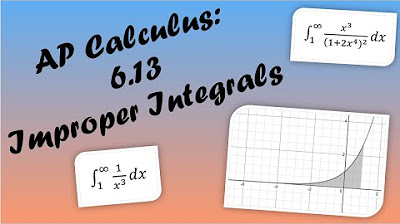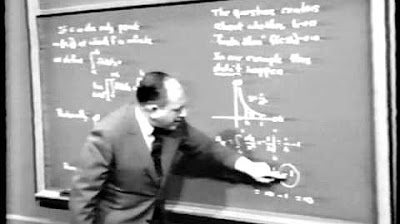Evaluating Improper Integrals
TLDRIn this educational segment, Professor Dave explores the concept of improper integrals, which occur when an integral's limits include infinity or when the function has an infinite discontinuity within a finite interval. Through examples like integrating 1/x^2 from 1 to infinity, he demonstrates that, contrary to initial assumptions, some functions with infinite intervals can yield finite areas. This includes showing how calculus can discern between convergent integrals with finite results and divergent ones. The tutorial also covers evaluating these integrals by replacing infinity with a variable and examining the limit as it approaches infinity, providing insights into the intriguing intersections of infinite processes and finite outcomes in mathematics.
Takeaways
- 😀 Improper integrals involve integration over an infinite interval or an interval with a discontinuity.
- 😮 We can evaluate some improper integrals by taking a limit, replacing ∞ with a variable and seeing what happens as that variable approaches ∞ or a discontinuity.
- 🤔 An improper integral can yield a finite number even when integrated over an infinite interval. This happens when the function gets small enough fast enough.
- 😲 A function that yields a finite integral over an infinite interval is called convergent. If the integral diverges to infinity, it is called divergent.
- 😕 It can be difficult to determine by inspection whether an improper integral will converge or diverge.
- 🧐 Integrating 1/x^2 from 1 to ∞ converges to 1. But integrating 1/x diverges, showing that subtle differences in functions can change convergence.
- 🤯 Integrating 1/(1+x^2) from -∞ to ∞ incredibly yields the finite value π!
- 😊 Vertical asymptotes within a finite interval can also lead to improper integrals, evaluated similarly by taking limits.
- 🥳 Recognizing improper integrals is critical, as evaluating them wrongly as definite integrals yields incorrect values.
- 😃 With understanding of limits, improper integrals can be evaluated systematically to yield incredible results.
Q & A
What is an improper integral?
-An improper integral occurs when one of the limits of integration is infinity, negative infinity, or the integrand has an infinite discontinuity or vertical asymptote within the interval.
How do you evaluate an improper integral with an infinite limit?
-Replace the infinite limit with a variable t, evaluate the integral from the finite limit to t, then take the limit as t approaches infinity or negative infinity.
What does it mean for an improper integral to be convergent?
-An improper integral is said to be convergent if the limit exists and results in a finite number as the evaluation point approaches the infinite or discontinuous limit.
What does it mean for an improper integral to be divergent?
-An improper integral is said to be divergent if the limit does not exist or results in an infinite value, meaning the area under the curve is infinite.
How can you tell if an improper integral will converge or diverge?
-It is difficult to determine convergence or divergence just by looking at the integrand. You must evaluate the integral to see if a finite limit results.
What is an example of a convergent improper integral?
-The integral from 0 to infinity of 1/(1+x^2) dx converges to π.
What is an example of a divergent improper integral?
-The integral from 1 to infinity of 1/x dx diverges.
How do you evaluate an improper integral with a vertical asymptote?
-Replace the limit at the vertical asymptote with a variable t, evaluate the integral, then take the limit as t approaches the asymptote value.
Why is recognizing an improper integral important?
-Because improper integrals must be evaluated differently than standard definite integrals in order to obtain the correct value.
What can make an integral over a finite interval improper?
-A vertical asymptote within the interval of integration can make a finite interval integral improper.
Outlines
😀 Introducing improper integrals
Improper integrals arise when one of the limits of integration is infinity or the function has an infinite discontinuity. They require special methods because the area under the curve may be finite despite the infinite interval. We can evaluate them by replacing infinity with a variable and examining the limit.
😕 Convergent and divergent intervals
Some improper integrals converge to a finite value (convergent) while others diverge to infinity (divergent). Convergent intervals like 1/x^2 become small fast enough while divergent ones like 1/x don't. Determining convergence can be difficult by inspection alone.
😃 Evaluating integrals with vertical asymptotes
Improper integrals also occur when the function has a vertical asymptote inside the interval. We replace the asymptote value with a variable and evaluate the limit as it approaches the asymptote. This can also yield finite values.
Mindmap
Keywords
💡improper integrals
💡indefinite integrals
💡convergent
💡divergent
💡vertical asymptote
💡limits of integration
💡substitution
💡antiderivative
💡natural log
💡tangent
Highlights
Researchers developed a new technique to detect subtle shifts in Earth's magnetic field.
The new method uses satellite data and AI to model the magnetic field more precisely.
Small fluctuations in the magnetic field can indicate changes happening deep within Earth's core.
Understanding the magnetic field provides insight into Earth's interior and geomagnetic processes.
The enhanced sensitivity of this technique could enable better navigation and exploration.
Researchers trained a convolutional neural network on magnetic field data from satellites.
The AI model learned to filter noise and identify meaningful magnetic field signals.
This allows smaller magnetic field variations to be detected compared to previous methods.
The researchers validated the technique using real satellite data from the Swarm mission.
The new method could lead to better geomagnetic models and a deeper understanding of the core.
Precisely tracking the magnetic field may help predict future geomagnetic storms.
The AI technique could be applied to model other complex geophysical phenomena.
The approach demonstrates the power of AI for revealing insights in scientific data.
Researchers plan to expand the method with more satellite data for greater coverage.
Overall this represents an important advancement in geomagnetism and space physics.
Transcripts
5.0 / 5 (0 votes)
Thanks for rating:





